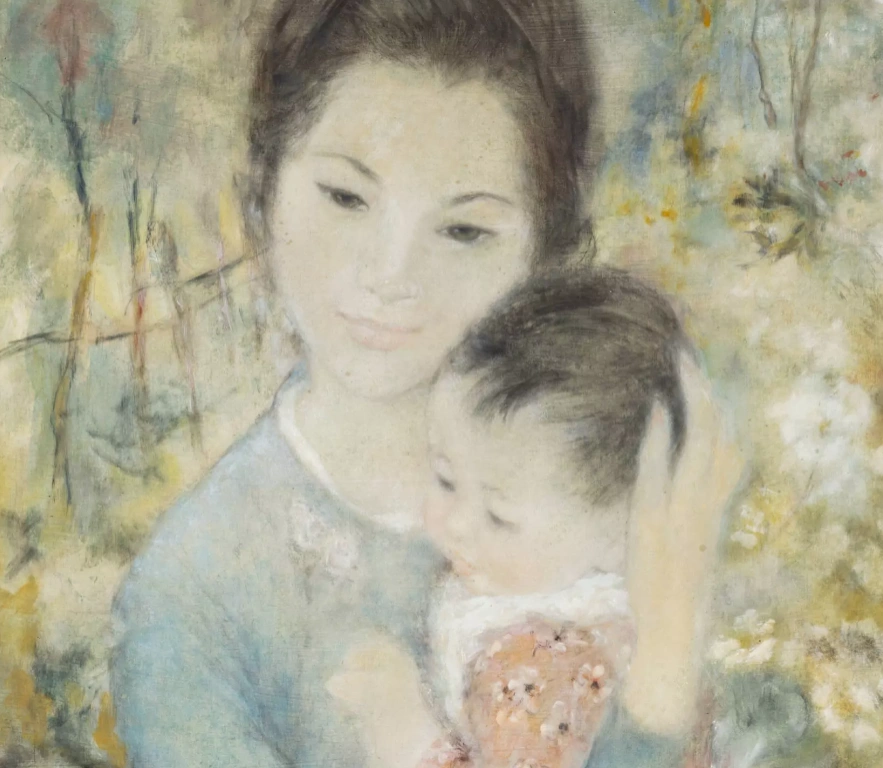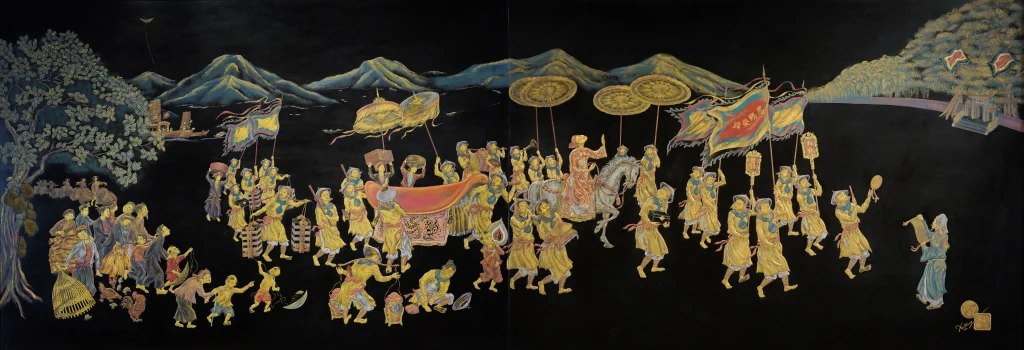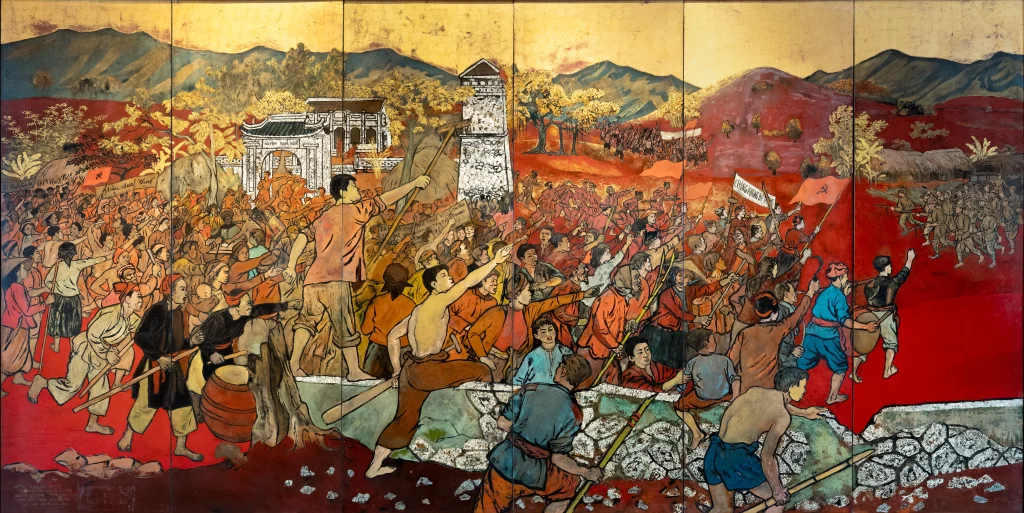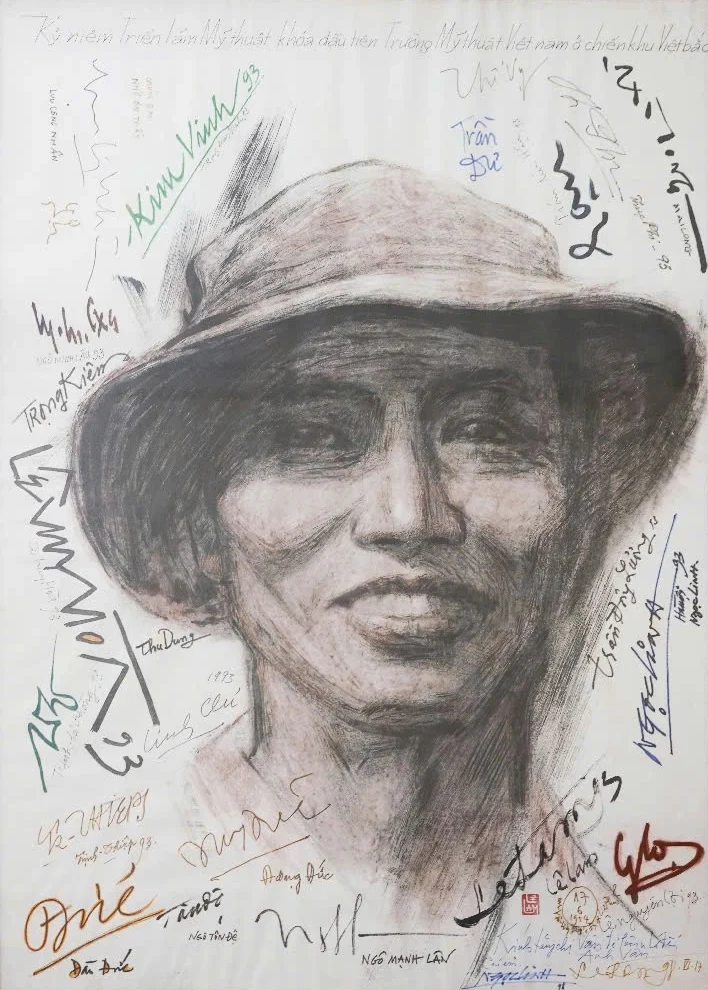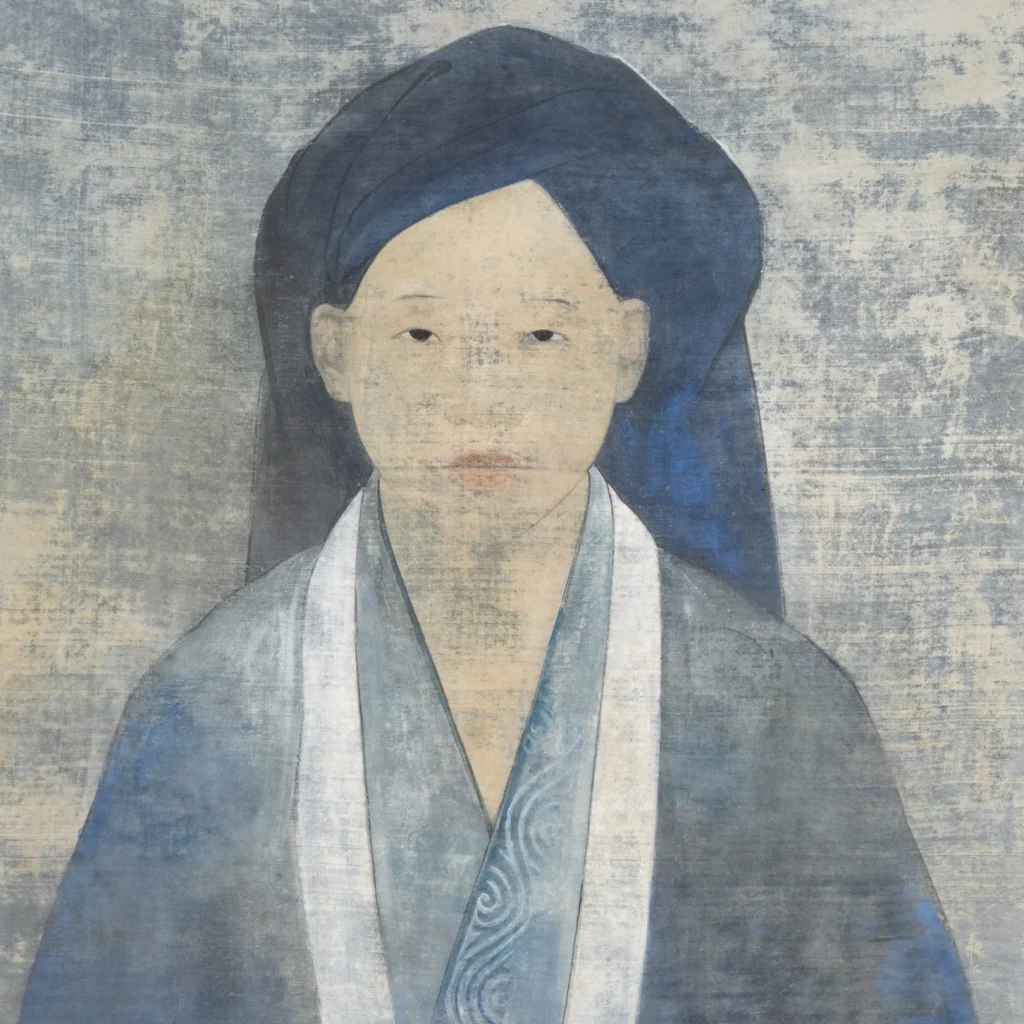Lê Thị Lựu is a talented and beautiful artist. She seems to possess all the qualities considered perfect and admired. As a woman, she is pretty, a gentle mother, a devoted wife, a loving daughter. As an artist, she possesses all the excellent qualities, from visual techniques, artistic creativity to humanistic content. All these elements have created a symbol of Vietnamese painting named Lê Thị Lựu in one of the most golden periods (1925 – 1945).
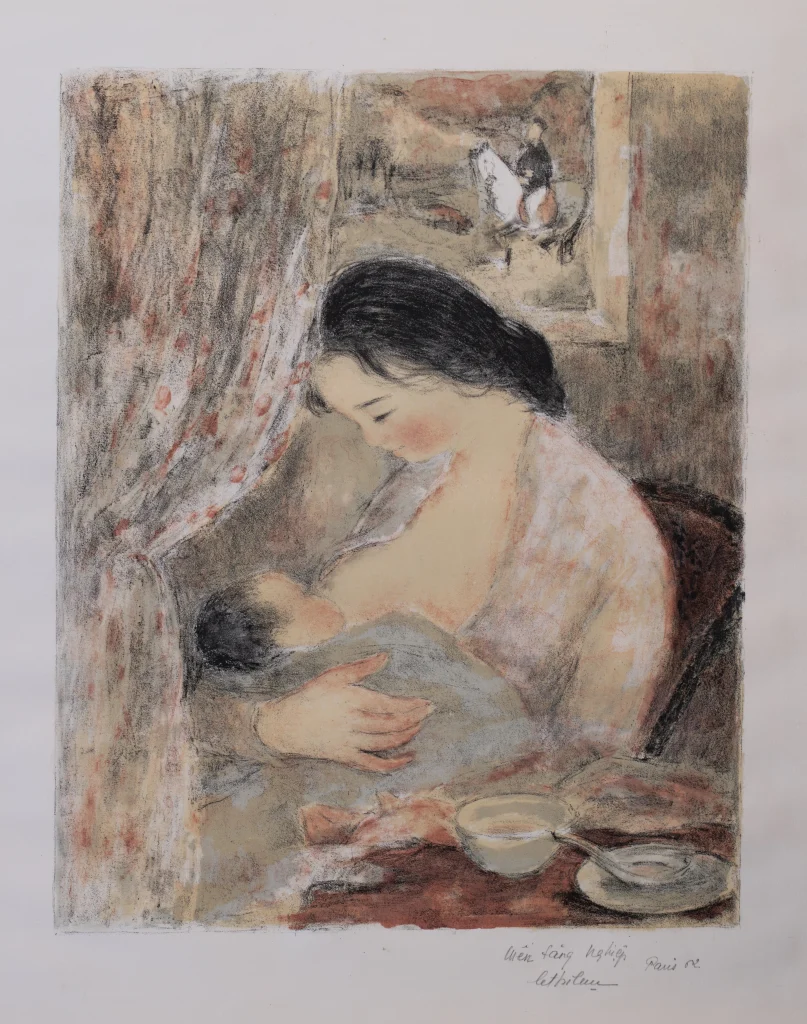
LÊ THỊ LỰU (1911 – 1988). “Meal in mother’s lap”, Paris, 1962, mix media on silk, 55,8 × 45,1 cm
Signed, dedicated, located and dated in the lower right corner
Collection of Madame K.,Paris (a gift from the artist and kept ever since)
Lê Thị Lựu with a number of first and only
“In more than thirty years of continuous creation, Lê Thị Lựu did not paint much, her paintings were scattered and wandering, if you want to estimate, the number of two to three hundred seems closest. Most of them are silk, a very few are oil paintings. The theme is in the word ‘thiếu’ of words for women and children…” – Writer Thụy Khuê (currently living in France), a close friend, who understands and loves Lê Thị Lựu’s paintings, shared.
Yes, her career is encapsulated in those seemingly simple summaries, but the emotion, rich in humanity of a woman worked in art, along with the talent that has been recognized since the artist studying at Indochina Fine Arts College, has made Lê Thị Lựu’s works one of the special symbols of Vietnamese Fine Arts with “first” and “only”.
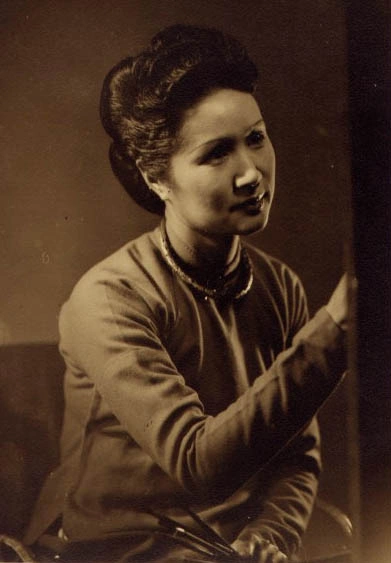
Portrait of artist Lê Thị Lựu (1911 – 1988)
Lê Thị Lựu is the first female student of Indochina Fine Arts College and also the only female student to graduate as Valedictorian of class III (1927-1932) and of all Indochina classes; Being the only female artist to graduate from the school and live and work abroad; And later, up to 2025, Lê Thị Lựu is also the first and only Vietnamese female artist to have achieved a high price for a work sold at international auctions.
Features which create the value of the work Meal in mother’s lap
Lê Thị Lựu was born into a traditional family in Thổ Khối village, Thuận An district, Bắc Ninh province. Her parents gave birth to four daughters and named them after herbs: Ms Lựu, Ms Cẩn, Ms Chương, Ms Đào1. After graduating, she taught painting in Hà Nội, Huế and Sài Gòn. In 1940, she followed her husband, Ngô Thế Tân, an engineer, to settle in France. After 35 years of living abroad, she only had the opportunity to visit her homeland once in 1975. Before passing away in 1988, she made the silk work “Three genarations” as a way to tell an emotional story about Vietnamese cultural traditions in a film with the theme “the beloved homeland Việt Nam is always in my heart”.
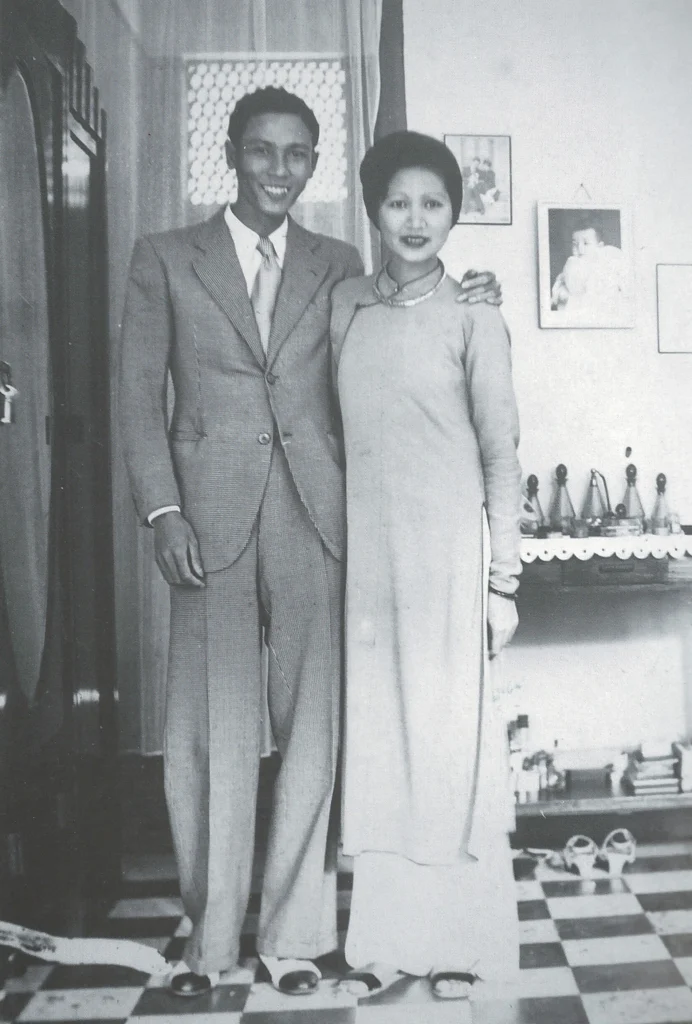
Artist Lê Thị Lựu and her husband Ngô Thế Tân
The silk work Meal in mother’s lap is one of the most special silk works of Lê Thị Lựu that will be displayed and auctioned in the duplex auction titled “1925 – 2025, Legends and Future”, at Millon Auction House (France), held on November 16, 2025 in Hà Nội.
Basically, the work Meal in mother’s lap by Lê Thị Lựu is specially appraised on two aspects – Historical value based on comparisons and cross-references of documents and artistic value including manner, style and techniques to create emotions and aesthetic vibrations.
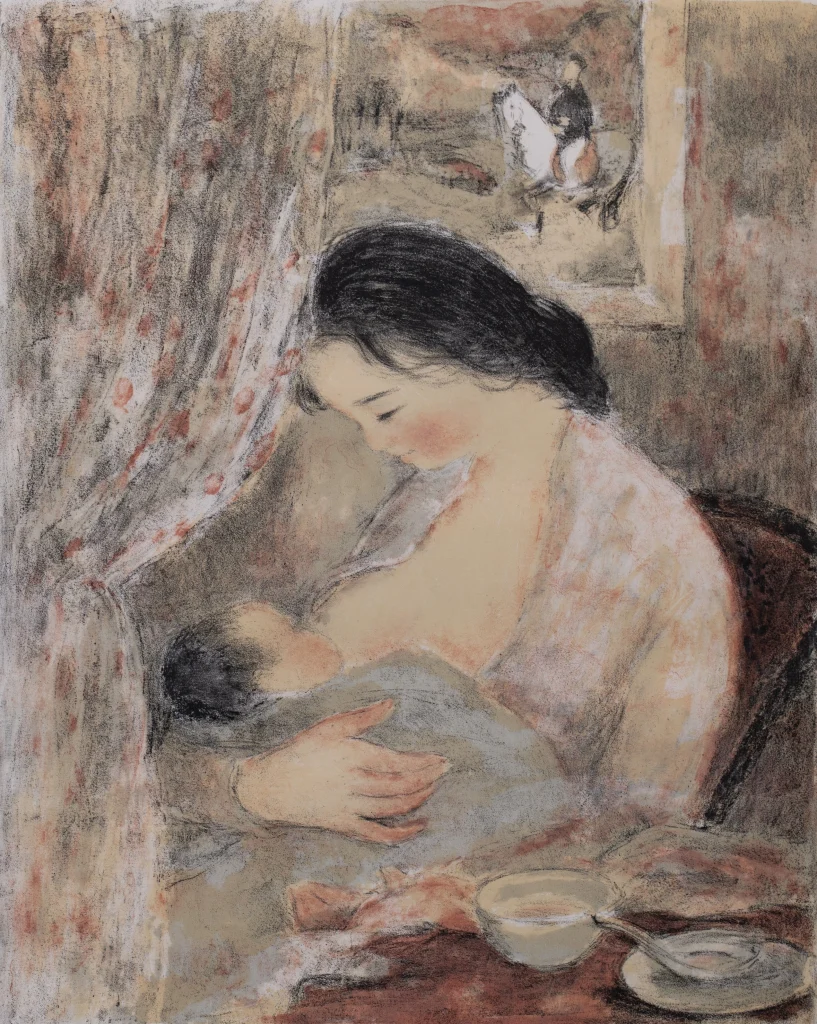
LÊ THỊ LỰU (1911 – 1988). Meal in mother’s lap, Paris, 1962, mix media on silk, 55,8 × 45,1 cm.
The special historical value of Meal in mother’s lap is appraised based on references to her other works. Firstly, the work was created in 1962, according to experts, this was the peak decade in Lê Thị Lựu’s career. Secondly, the work was created on her favorite theme – women and children, specifically mother and child. Thirdly, the most special point is that this is perhaps the only work (among her known works) depicting a mother breastfeeding her child. Not only that, she created a bold image of the mother by revealing two-thirds of her breasts. The exposure of flesh in Lê Thị Lựu’s works is already rare, now it exposes the sensitive part, a special point that is both interesting and rare. To explain this, we need to go back a little to the past.

While studying at Indochina Fine Arts College, Lê Thị Lựu was recognized as an outstanding talent. In 1932, Phong Hóa newspaper wrote: “It is worth noting that Ms. Lê Thị Lựu did not hesitate to be a woman, to compete with male artists, but her talent and skill were superior to others, which is truly a pride for women in the country.”2 In addition, art critic Yvonne Schultz also wrote: “The second painting depicts the Uncle, the rakish style reminds me of Reynolds.”3
This shows that her creative artistic innovation was expressed in her works even when she was still a student. Although she was raised in a family of traditional moral principles, where traditional moral standards such as “work, beauty, speak, virtue”, “three obediences and four virtues” were considered the guiding principles, deep inside she still had a soul which wanted to absorb new features.
From 1940 when she followed her husband to France until the 1950s, she devoted all her time to taking care of her family. In 1954, she returned to art in a more profound way. The “discreet feminine innovation” of the work Meal in mother’s lap might have originated from the soul of an artist with a lot of inner strength, wanting to express the emotions, spirit, and aspirations in herself since her youth, which had remained intact for years. In addition, this innovation may have been influenced by the feminist movement of the 1950s and 1960s in Europe and America with the desire to change the old concept of “a woman’s life will be complete when she spends her whole life being a housewife, a wife and a mother” to a new concept.
However, basically, Lê Thị Lựu was still an artist with all the qualities of an Eastern woman, so the views of that era only silently took place in her consciousness and were implicitly present in some works. But clearly, the desire to create is always strong in her artistic soul, when those innovations are expressed in any work, that work will become special.
Currently, the work that she describes most fleshly and is on display to the public is probably the work Girl bathing by a lotus pond, created around 1970 – 1971 (in the collection of Ms Thụy Khuê and Mr Lê Tất Luyện, donated to Hồ Chí Minh City Fine Arts Museum). The work depicts “a girl sitting sideways, her wet hair loose, her head turned, a thin silk scarf covering part of her body, revealing, waiting.”2 According to writer Thụy Khuê, in Lê Thị Lựu’s entire career, “she only made two works of nude (Ms D. hung it in her bedroom) and it was also very ‘dignified’.”4
In addition to the special historical features, the artistic value that creates the emotions of Meal in mother’s lap contributes significantly to the success of the work, especially the interesting things found when analyzing the character’s psychology.
In this work, Lê Thị Lựu has absolutely deeply expressed the maternal connection. The baby’s soul is nurtured in the warm, loving arms of the mother; that love radiates from the face, from the gentle look in the mother’s eyes. At the same time, the baby is nourished with milk – the source of life; the baby’s meal is from the mother herself. From these two meaningful images, Viet Art View considered and finally titled the work Meal in mother’s lap so that the meaning could be closest to the message – the child is nourished by the mother from body to soul.

Artist Lê Thị Lựu, Paris – 1941
In order to be able to deeply express the wonderful communication between a mother and her child, in addition to artistic talent, compared to other artists, Lê Thị Lựu seems to have an advantage because she was a mother, having experienced such emotions. Not only that, she was also a Vietnamese woman, born in a country that highly values tradition of family. Therefore, Meal in mother’s lap is a work imbued with Vietnamese spirit.
In 1940, Lê Thị Lựu followed her husband, away from her homeland, away from her parents, so she poured all her longing into her works. The most beautiful paintings in her creative career were all in the 1960s. The works reached the peak of form, color harmony, style, brushwork and technique.
Lê Thị Lựu worked in both oil and silk. Since 1954, she began to change the traditional silk work style; not using a flat, monochromatic color but using light and dark, streaks and brush strokes. By 1956, silk was her number one priority because this material was especially suitable for femininity. Her works were always gentle with soft colors, clearness, and graceful brush strokes. The works all exuded a gentle, dreamy nostalgia. Especially in the landscapes, whether with or without characters, the feeling showed that this was a work drawn by a gentle Eastern soul.
The work Meal in mother’s lap is one of the pinnacles of Lê Thị Lựu’s art. Her unique style and artistic techniques have also contributed to creating a profound maternal-child interaction imbued with poetry and lyricism. The image of the mother is the main one, occupying two-thirds of the painting.
The mother sits in a position that is both steady and somewhat relaxed, so that her arms can both lift and embrace the child. That embrace is tight enough to convey a feeling of protection, but also soft enough for the child to be most comfortable. In particular, the hand supporting the baby – very beautiful and feminine – seems a bit large compared to the general proportions of the mother’s body. This is not a coincidence, but a hidden meaning emphasizing the “support” element, symbolizing the power of protection. When combined with the solid color of the chair, along with the softness of the loose curtain, the way of contrasting shape and substance further highlights the two characters in their emotional interaction. The mother’s face with gentle eyes looking down, meets the gaze of her child looking up at her. This is a difficult pose to portray, requiring both academic techniques and a subtle expression of emotional depth. Here, the image of mother and child is not only standard in visual but also rich in spirit, filled with maternal love.
This basic standard appearance, combined with a light, warm pink color, with the technique of covering colors with fluffy, floating sense typical of Lê Thị Lựu seems to be creating “smell and taste” that is symbolic; The scent of mother’s milk, the scent from the baby’s skin, the scent of happiness seemed to spread from both the mother and her child, filled the room with peaceful warmth.
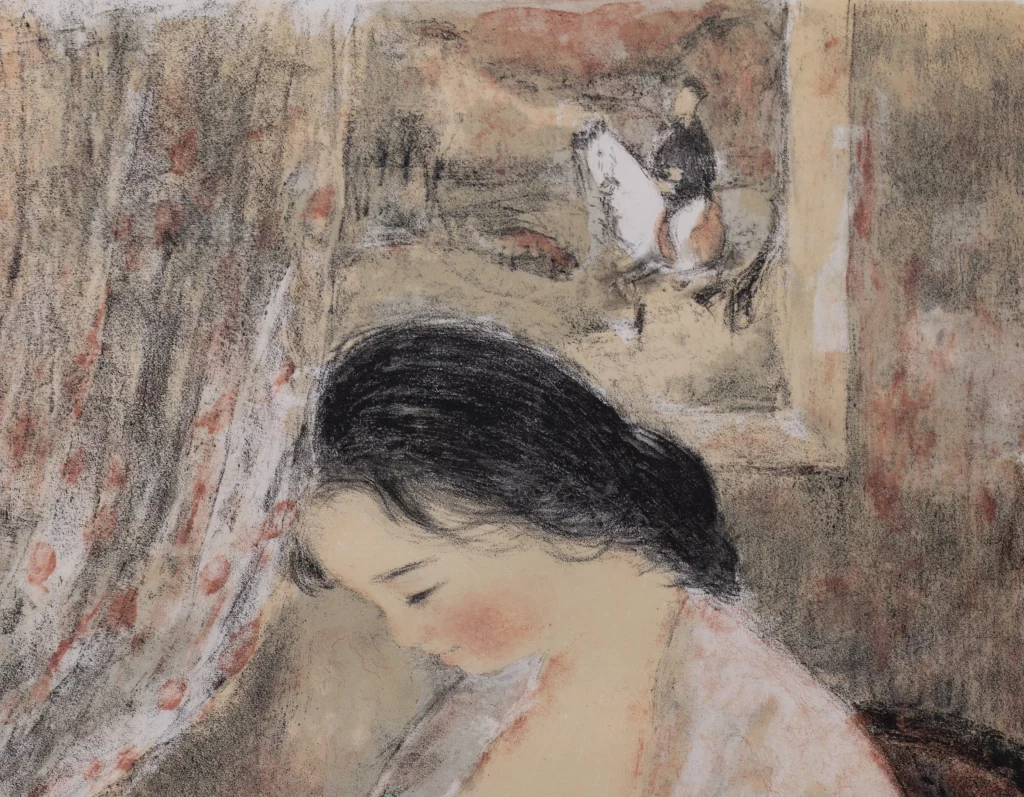
For art lovers, owning a “two-in-one” work of art, which we often call “a painting within a painting”, is always an interesting thing. In Lê Thị Lựu’s work, we also see another painting by artist Vũ Cao Đàm – her friend and peer in France. Not only that, the content of these two works are the most successful themes of the two famous artists. With Lê Thị Lựu – the theme of mother and child, with Vũ Cao Đàm – the theme of man and horse.
The “inside painting” depicts a man with black outfit and a white horse. His appearance is both confident, majestic, and leisurely in a mountain scene, it seems to give the viewer the feeling of a man with heroic spirit and excellent qualities. After nine months of pregnancy and childbirth, a little angel will cry out to be born. Whether a son or a daughter, every mother certainly wishes for a bright future for her child. When bringing the image of an idealized man in Vũ Cao Đàm’s works to appear in her special work, Lê Thị Lựu also metaphorically spoke about a rosy future with beautiful dreams on behalf of all mothers.
Leaving an imprint
In 2025, Vietnamese Modern Fine Arts is 100 years old. During those 100 years, creative periods and generations of artists have been formed and developed along with the country’s fine arts history. In particular, the period of the artists of Indochina Fine Arts College (1925 – 1945) is a symbol with golden milestones and legendary artists, and Lê Thị Lựu is one of the legendary names.
According to experts, the vitality and lasting value of a work of art lies not only in the visual aesthetic factor, but also in the ability to raise the desire to own it in connoisseurs and collectors. A work that is especially sought after by collectors often possesses three core qualities: Rare – because of its limitation and uniqueness; Valuable – because it was created during the most brilliant period of the artist’s career; Special – thanks to the unique mark of the brushwork, style, and depth of thought and content. It is these unique combinations that have turned the work into a symbol, transcending its value to become a precious value in history and art. The silk work Meal in mother’s lap of Lê Thị Lựu seems to have fully converged these factors.
After years of dedication to art, the talented and beautiful artist has left posterity one of the most outstanding and special works in her art treasure.
*Notes in the article use materials from the article “Lê Thị Lựu, Sunset Impressions” by writer Thụy Khuê.
Written by Viet Art View
Copyrights belong to Viet Art View


